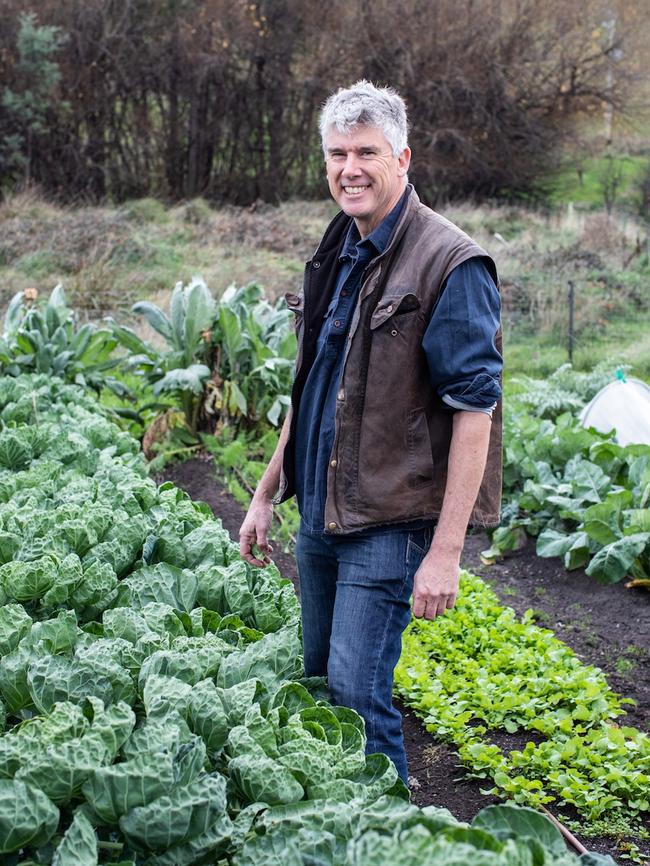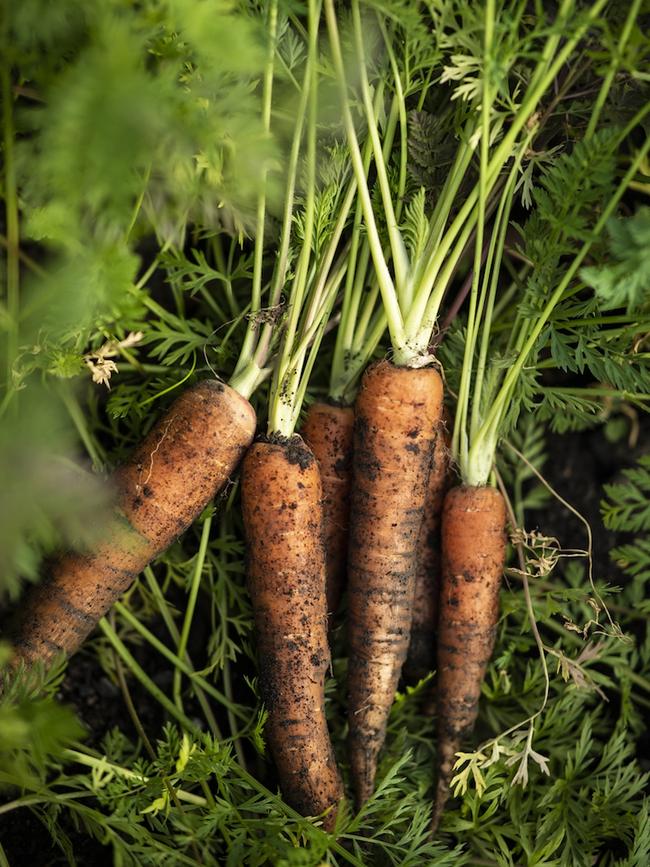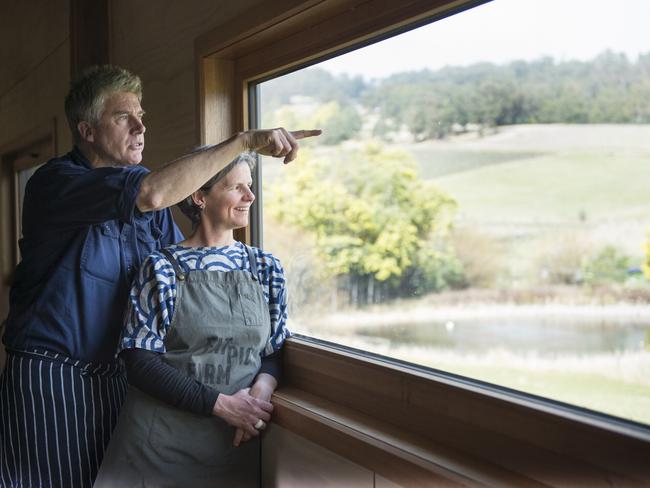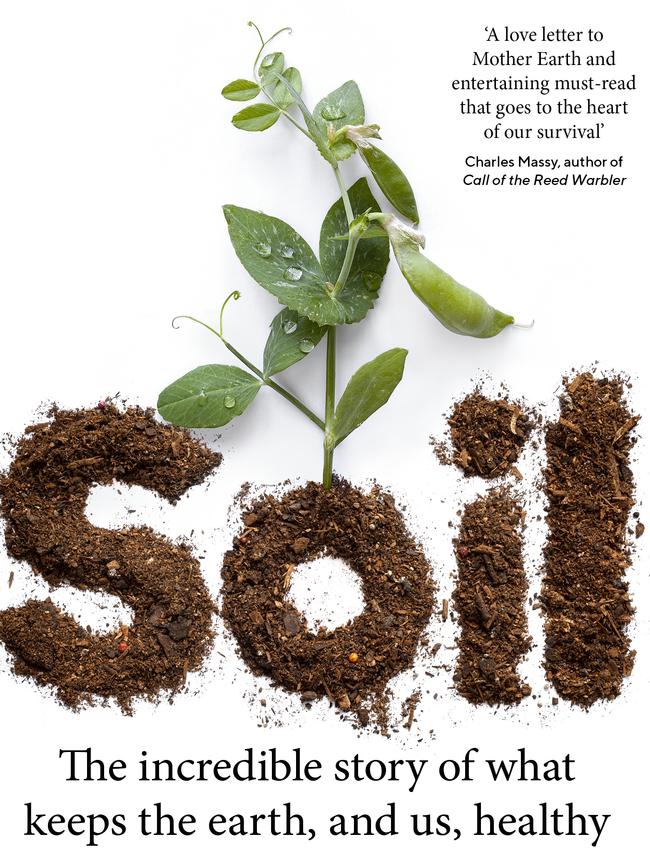It’s seldom the subject of poems or songs and never of paintings. The praises of the stuff that keeps us alive – supplying 98 per cent of our calories – are seldom sung.
Into this breach has stepped Matthew Evans, to tell the story of soil, especially the very small part of it that we can use for growing food – just 7.5 per cent of the planet’s surface, and much of that covered with cities and roads.
Evans’s relationship with the soil became much more intimate when, 12 years ago, he stopped being a restaurant critic in Sydney and became a farmer in Tasmania – a process we got to follow on the SBS Gourmet Farmer series.
At Fat Pig Farm outside Cygnet, he and his partner Sadie Chrestman now grow enough food to provide 5000 feasts a year. When last year’s Covid lockdown put paid to hospitality he was also recovering from being gored by a sow, so sedentary research and writing was a great use of his time to finish off a two-year project, Soil: The incredible story of what keeps the earth, and us, healthy.

Informed by a trade as a chef and a degree in applied science, as well as experience as a grower of food, he says a “confluence of ancient wisdom and recent discoveries” led him on.
It was only 1996 that glomalin, the fungi that is the glue that allows soil to clump – like the egg in a cake – was discovered.
Yet thousands of years ago people in the Amazon Basin were adding charcoal to soil, creating Dark Earth so rich in organic matter, carbon, nitrogen and phosphorus that “you can grow twice as much food in the same space, with the same labour, that you can on nearby soil that isn’t black”.
In the 1980s it was discovered (in the course of investigating wheat blight) that soil and plant bacteria often form the nuclei of hail and snow, and so fall to earth as rain.
For thousands of years people have known to rotate crops and to rest soil in between. But the knowledge of soil erosion took a giant leap only in the two years to 2018, when there was more published on the topic than in all of the 20th century.
Whether you are honouring Mother Nature following the “watching and learning” route, or gulping up the latest science, there is more attention on soil now than ever before. And not a day too soon.

Good soil is a living, breathing thing – yes; the air in the top 20cm of soil is completely renewed every hour – and there are more living things in a teaspoon of healthy soil than there are humans on the planet.
It is also a complex economy. Through photosynthesis, plants produce sugars out of thin air. A goodly proportion of these sugars dribble out of their roots to microbes and fungi gathering around “like fish at a jetty”.
In return, those organisms “trade” the micronutrients a plant needs. Hyphae are tiny fungi threads (there will be 10km of them in a teaspoon of healthy soil) that stretch out in all directions and are a conduit for nutrients.
In soil that’s working well, the roots of a plant can access up to 2000 times more soil and all its goodies through the action of fungi, mites, worms, algae, protists and bacteria.
However, if the farmer or gardener showers soil with artificial fertilisers, the soil becomes lazy. As the plant is being spoonfed, it does not have to trade sugars for what it wants, the roots do not have to go as deep, and all those microbes and fungi just take it easy.
Unfortunately, the result of the artificial inputs is that the vegetables, fruits and meat grown on that soil have fewer nutrients than food grown in busy soil.
Evans cites examples from studies that show modern wheat is 22-39 per cent less nutritious than it was 100 years ago, and that carrots in the UK today have a third of the vitamin C they did in the 1960s.
“Nowhere in our current agricultural system is there any motivation to grow nutrient-dense food,” Evans writes. “Hence our recent success in growing the least nutrient-dense food in human history.”

Farmers are paid for weight, produce that looks good, and that which is able to be transported and stored. “Most changes to crops have benefited producers, very few the eaters,” he says.
The beginning of the book is not cheery, as Evans describes how soil, from which comes “just about everything we need”, has been treated like dirt.
In China, one in every five hectares of arable land is poisoned by heavy metals and 81 per cent of its coastline is considered heavily polluted from farming and industrial run-off.
In “clean, green” New Zealand, three-quarters of native freshwater fish are under threat of extinction, mostly because of nitrogen fertiliser run-off from dairy farms.
Only 20-30 per cent of the nitrogen put on plants is actually used by them. Not only are we polluting soil, but we are squandering it – letting it blow, wash and slip away through erosion. These two effects have caused the loss of about one third of crop land in the past 40 years.
And the simplistic solution of getting rid of grazing animals to counter climate change is wrongheaded. Grazing does much more to stimulate the roots of grass than mowing.
Imagine the soil enrichment when 30 million defecating and dying bison roamed the prairies of the America before it became the US.
There is also the “pepper shaker effect” of bats, birds, rodents, marsupials and insects going about their ablutions. But there needs to be trees about. Neither crops in huge fields sprayed with pesticide nor animals in big feedlots do the trick, but soil is not designed to be without animals.

The mood lifts as the book progresses to worms, compost, charcoal, regenerative farming, the benefits of gardening to “our heads, our hearts, our backs, our immune systems” and carbon sequestration.
The “wonderful interface where plants meet soil and most soil life abounds” is known as the rhizosphere – and it could well be the saving of the atmosphere.
Until the 1950s, the biggest emitter of carbon from soil into the atmosphere was the plough.
“The idea that a quarter of the increase in carbon in the atmosphere still is due to the plough is astonishing, but it also gives you hope, because it’s carbon that can be stored again, which is not the case with burning fossil fuel,” Evans says.
“If we could put back 15 or 25 per cent of carbon we have emitted back in the soil it’s just a beautiful thing that’s full of hope. And, generally there is very little farming land that would not benefit from more carbon back in the soil.”
Soil is 40,000 words, or more than a third, shorter than the manuscript Evans originally gave his publisher. Discarding so much work was painful, but the result is a de-nerded book, making it not only accessible to the general reader, but providing a smack to the gob every few pages.
Evans is feeling some trepidation about speaking to the real nerds at the Soil Science Australia conference in Cairns later this month. His real target is to alert the non-experts to the fact that soil is “over-utilised, underappreciated, and under pressure”.
“I want to put it out there that this is something that, whether you know it or not, this matters to you, and this is why it matters,” he said. “It was actually a great experience writing it; really nice to take a very simple topic and find out lots of things about it.” ●
Soil, by Matthew Evans,
Murdoch Books, RRP $33


Add your comment to this story
To join the conversation, please log in. Don't have an account? Register
Join the conversation, you are commenting as Logout
Ranked: Secret customer benefits of Australia’s best loyalty programs
From free coffees to mega perks, Aussie retailers’ loyalty programs have evolved into sophisticated powerhouses in an $8bn battle to lure customers. The best rewards programs ranked >>
‘They had to hold my throat open so I didn’t bleed out’
A Tasmanian local footballer has recalled the horror Bali accident which nearly killed him as he now sprints towards some unlikely Paralympic glory.